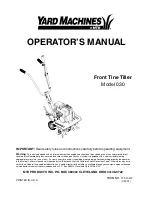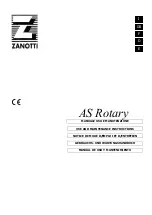
Water Pump Interlock Circuits and Flow
Switch Input
D
WARNING
Hazardous Voltage w/Capacitors!
Disconnect all electric power, including remote
disconnects and discharge all motor start/run capac-
itors before servicing. Follow proper lockout/tagout
procedures to ensure the power cannot be inadver-
tently energized. For variable frequency drives or
other energy storing components provided by Trane
or others, refer to the appropriate manufacturer’s
literature for allowable waiting periods for discharge
of capacitors. Verify with an appropriate voltmeter
that all capacitors have discharged. Failure to discon-
nect power and discharge capacitors before servicing
could result in death or serious injury.
Note: For additional information regarding the safe
discharge of capacitors, see PROD-SVB06A-EN or
PROD-SVB06A-FR
Chilled Water Pump.
1. Wire the evaporator water pump contactor (5K1) to a
separate 120 volt single phase power supply with 14
AWG, 600 volt copper wire
2. Connect circuit to 1A5-J2-6
3. Use 1A5-J2-4 120 Vac output to allow the control pan-
el to control the evaporator water pump, or wire the
5K1 contactor to operate remotely and independently
of the control panel.
Chilled Water Proof of Flow.
When installed properly, this circuit only allows com-
pressor operation if the evaporator pump is running and
providing the required minimum water flow.
1. Wire the auxiliary contacts of the evaporator water
pump contactor (5K1) in series with the flow switch
(5S1) installed in the evaporator supply pipe with 14
AWG, 600-volt copper wire
2. Connect circuit to control panel terminals lX1-5 to
1A6-J3-2.
Condenser Water Pump.
1. Wire the condenser water pump contactor (5K2) to a
separate 120-volt, single phase power supply with 14
AWG, 600-volt copper wire
2. Connect circuit to control panel terminals 1A5-J2-3
3. Use 1A5-J2-1 120 Vac output to allow the control pan-
el to control the condenser pump.
Condenser Water Proof of Flow.
When installed properly, this circuit only allows the com-
pressor to operate if the condenser pump is running and
providing the required minimum water flow.
1. Use 14 AWG, 600-volt copper wire to connect the
auxiliary contacts of the condenser water pump
contactor (5K2) in series with the flow switch (5S2)
installed in the condenser supply pipe
2. Connect circuit to control panel terminals 1X1-6 to
1A6-J2-2
Temperature Sensor Circuits
All temperature sensors are factory installed except the
optional outdoor air temperature sensor. This sensor is
required for the outdoor air temperature type of chilled
water reset. Follow the guidelines below to locate and
mount the outdoor air temperature sensor. Mount the
sensor probe where needed, however, mount the sensor
module in the control panel.
CWR - Outdoor Option.
The outdoor temperature sensor similar to the unit
mounted temperature sensors in that it consists of the
sensor probe and the module. A four-wire IPC bus is con-
nected to the module for 24 Vdc power and the commu-
nications link. Trane recommends mounting the sensor
module within the control panel and the sensor two
wire leads be extended and routed to the outdoor tem-
perature sensor probe sensing location. This assures the
four wire IPC bus protection and provides access to the
module for configuration at start-up.
The sensor probe lead wire between the sensor probe
and the module can be separated by cutting the two
wire probe lead leaving equal lengths of wire on each
device; the sensor probe and the sensor module. Note
this sensor and module are matched and must remain
together or inaccuracy may occur. These wires can then
be spliced with two 14–18 AWG 600V wires of sufficient
length to reach the desired outdoor location, maximum
length 1000 feet (305 meters). The module four- wire bus
must be connected to the control panel four-wire bus
using the Trane-approved connectors provided.
The sensor will be configured (given its identity and
become functional) at start-up when the serviceman
performs the start-up configuration. It will not be opera-
tional until that time.
Note:
If shielded cable is used to extend the sensor
leads, be sure to tape off the shield wire at the
junction box and ground it at the control panel.
If the added length is run in conduit, do not run
them in the same conduit with other circuits car-
rying 30 or more volts.
D
NOTICE
Electrical Noise!
Maintain at least 6 inches between low-voltage (<30V)
and high voltage circuits. Failure to do so could result
in electrical noise that may distort the signals carried
by the low-voltage wiring, including the IPC.
50
RELEASED 10/Mar/2020 06:59:20 GMT
















































